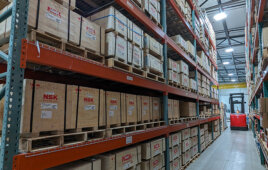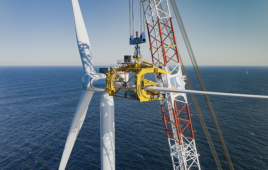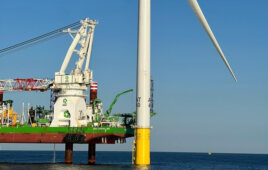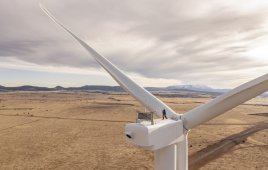Gears and gear manufacturing: Uncontrollable and highly variable wind forces adversely affect the performance and reliability of planetary gears inside wind-turbine power transmissions. A couple developments can lower maintenance on rolling elements and carry greater load in a planetary gearset. The first idea is to equalize gear loads, reducing internal stresses and significantly extending wind turbine reliability. The load sharing idea can be used in open planetary gear sets and consists of a double-cantilevered pin supporting the bearing and gear. The cantilevered pin attaches to a single carrier wall, and a cantilevered sleeve mounts to the free end of the pin. Gears and bearings mount on the sleeve.
Two opposing arrays of these bearings mounted on a double-wall planetary carrier let the drive carry up to 50% more torque. Furthermore, the integrated bearing and gear construction is simplified to provide more space for rolling elements to maximize the power rating of the bearing system. For max durability, coatings may be applied to the rolling and sliding surfaces. The result: More evenly distributed torque among multiple planet gears and longer gear and bearing life. In addition, combining shafts, bearings, and gears in one unit also cuts weight and lowers cost.
Conventional turbine design uses a gearbox to speed the slow, but high-torque power in a main shaft to a higher rotational speed useful to the generator. Conventional utility-scale wind turbines often use three- stage gearboxes. The first stage is often a planetary drive because that design handles high torque best. The later two stages use helical gears.
To give an idea of the torque coming from a rotor, consider a 1.5-MW turbine working at its rated output. 1.5 MW = 2,011 hp.
Using the torque and speed relationship, assume about 15 rpm on the rotor. Using,
Php = ωT / 5,252 Where Php = power, (horsepower); ω = rotational speed, (rpm); T = torque, (lb-ft); and 5,252 is a conversion factor.
Solving for torque gives:
T = 5,252 Php/ ω
= 5,252 (2,011 hp) / 15 rpm
= 7.04 x 105 or about 700,000 ft-lb
That is, 700,000 ft-lb on the gearbox input shaft. Of course, a 1.5-MW turbine works at this full load only a small part of the time.
The calculation may prompt the question: What are the loads on a gearbox? Instead of a few figures, gearbox designers work with load cases, loads measured by sensors on working gearboxes over a period of time. That means loads are constantly changing. Also consider that equipment encounters the changing loads on a tall tower swaying in the wind and exposed to temperature extremes. Eventually, a rotor shaft and gearbox lose their alignment. That creates additional loads on the gearbox and bearings. The same happens between gearbox and generator. These conditions result in frequent gearbox failures and a reputation for unreliability. When a gearbox fails, the turbine must be taken off line (out of power production) while the gearbox is replaced, an expensive task that can take several weeks.
Shaft couplings: Flexible shaft couplings accommodate that slight misalignment between gearbox output shaft and generator shaft. Several designs have found favor. One steel-shaft coupling rated for up to 9,200 ft-lb is said to be free from wear and maintenance, work quietly, provide electrical insulation, and is torsionally soft and flexible in all directions.
Another design uses two sets of links, one on each end of a tube to form a double cardanic system. The links connect through rubber bushings. The manufacturer says it can be sized for any torque, needs no maintenance, its electrically insulated, damps noise and vibration, and is flexible in axial, angular, and radial directions.
More recent designs use a fiberglass composite membrane and fiberglass tube. Membranes at each end of the tube provide sufficient axial and angular flexibility. It’s rated for torques up to 14,750 ft-lb., has a low weight, and is maintenance free, electrically insulated, and torsionally stiff.
Filed Under: Components





There can be cons like frequent stopping and starting leads to fatigue loading and always need to overcome initial torque. However wind speed is variable, so efficiency might be lower and maintenance becomes higher.
Hi,
I’m new to this field. I’m interested in knowing electrical motor/generator operations. I have few questions here could you please help me. Qtn: I have a shaft rotating a minute and not rotating 10 seconds. i.e 1min rotates + 10sec stopped + 1min rotates + 10…and so on. In this case does gear box provides constant output? or does gear box needs continuous rotating shaft? what are the cons if the shaft stops like this?
Thanks a million in advance!